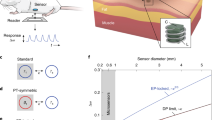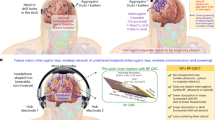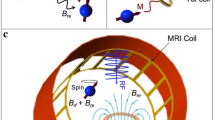Abstract
Biological electromagnetic fields arise throughout all tissue depths and types, and correlate with physiological processes and signalling in organs of the body. Most of the methods for monitoring these fields are either highly invasive or spatially coarse. Here, we show that implantable active coil-based transducers that are detectable via magnetic resonance imaging enable the remote sensing of biological fields. These devices consist of inductively coupled resonant circuits that change their properties in response to electrical or photonic cues, thereby modulating the local magnetic resonance imaging signal without the need for onboard power or wired connectivity. We discuss design parameters relevant to the construction of the transducers on millimetre and submillimetre scales, and demonstrate their in vivo functionality for measuring time-resolved bioluminescence in rodent brains. Biophysical sensing via microcircuits that leverage the capabilities of magnetic resonance imaging may enable a wide range of biological and biomedical applications.
This is a preview of subscription content, access via your institution
Access options
Access Nature and 54 other Nature Portfolio journals
Get Nature+, our best-value online-access subscription
$29.99 / 30 days
cancel any time
Subscribe to this journal
Receive 12 digital issues and online access to articles
$99.00 per year
only $8.25 per issue
Buy this article
- Purchase on Springer Link
- Instant access to full article PDF
Prices may be subject to local taxes which are calculated during checkout




Similar content being viewed by others
Data availability
The data that support the findings of this study are available within the paper and its Supplementary Information. All datasets generated for this study are available from the corresponding author on reasonable request.
References
Grosse, P., Cassidy, M. J. & Brown, P. EEG-EMG, MEG-EMG and EMG-EMG frequency analysis: physiological principles and clinical applications. Clin. Neurophysiol. 113, 1523–1531 (2002).
Jasanoff, A. Bloodless FMRI. Trends Neurosci. 30, 603–610 (2007).
Logothetis, N. K. What we can do and what we cannot do with fMRI. Nature 453, 869 (2008).
Bandettini, P. A. What’s new in neuroimaging methods? Ann. NY Acad. Sci. 1156, 260–293 (2009).
Regan, D. Human Brain Electrophysiology: Evoked Potentials and Evoked Magnetic Fields in Science and Medicine (Elsevier, New York, 1989).
Merletti, R. & Parker, P. A. Electromyography: Physiology, Engineering, and Non-Invasive Applications Vol. 11 (John Wiley & Sons, Hoboken, 2004).
Nunez, P. L. & Srinivasan, R. Electric Fields of the Brain: The Neurophysics of EEG (Oxford Univ. Press, New York, 2006).
Bénar, C. et al. Quality of EEG in simultaneous EEG-fMRI for epilepsy. Clin. Neurophysiol. 114, 569–580 (2003).
Pandarinath, C. et al. Neural population dynamics in human motor cortex during movements in people with ALS. eLife 4, e07436 (2015).
Cash, S. S. & Hochberg, L. R. The emergence of single neurons in clinical neurology. Neuron 86, 79–91 (2015).
Wang, J. Amperometric biosensors for clinical and therapeutic drug monitoring: a review. J. Pharm. Biomed. Anal. 19, 47–53 (1999).
Wang, J. Electrochemical biosensors: towards point-of-care cancer diagnostics. Biosens. Bioelectron. 21, 1887–1892 (2006).
Sofic, E., Lange, K. W., Jellinger, K. & Riederer, P. Reduced and oxidized glutathione in the substantia nigra of patients with Parkinson’s disease. Neurosci. Lett. 142, 128–130 (1992).
Bergamini, M. F., Santos, A. L., Stradiotto, N. R. & Zanoni, M. V. A disposable electrochemical sensor for the rapid determination of levodopa. J. Pharm. Biomed. Anal. 39, 54–59 (2005).
Wassum, K. M. et al. Silicon wafer-based platinum microelectrode array biosensor for near real-time measurement of glutamate in vivo. Sensors 8, 5023–5036 (2008).
Contag, C. H. & Bachmann, M. H. Advances in in vivo bioluminescence imaging of gene expression. Annu. Rev. Biomed. Eng. 4, 235–260 (2002).
Weissleder, R. & Ntziachristos, V. Shedding light onto live molecular targets. Nat. Med. 9, 123–128 (2003).
Lee, A. K., Manns, I. D., Sakmann, B. & Brecht, M. Whole-cell recordings in freely moving rats. Neuron 51, 399–407 (2006).
Kodandaramaiah, S. B., Franzesi, G. T., Chow, B. Y., Boyden, E. S. & Forest, C. R. Automated whole-cell patch-clamp electrophysiology of neurons in vivo. Nat. Methods 9, 585–587 (2012).
Hochberg, L. R. et al. Neuronal ensemble control of prosthetic devices by a human with tetraplegia. Nature 442, 164–171 (2006).
Spira, M. E. & Hai, A. Multi-electrode array technologies for neuroscience and cardiology. Nat. Nanotech. 8, 83–94 (2013).
Stosiek, C., Garaschuk, O., Holthoff, K. & Konnerth, A. In vivo two-photon calcium imaging of neuronal networks. Proc. Natl Acad. Sci. USA 100, 7319–7324 (2003).
Flusberg, B. A. et al. Fiber-optic fluorescence imaging. Nat. Methods 2, 941–950 (2005).
Seo, D., Carmena, J. M., Rabaey, J. M., Maharbiz, M. M. & Alon, E. Model validation of untethered, ultrasonic neural dust motes for cortical recording. J. Neurosci. Methods 244, 114–122 (2015).
Seo, D. et al. Wireless recording in the peripheral nervous system with ultrasonic neural dust. Neuron 91, 529–539 (2016).
Frank, S. & Lauterbur, P. C. Voltage-sensitive magnetic gels as magnetic resonance monitoring agents. Nature 363, 334–336 (1993).
Kruttwig, K. et al. Reversible low-light induced photoswitching of crowned spiropyran-DO3A complexed with gadolinium (III) ions. Molecules 17, 6605–6624 (2012).
Louie, A. Multimodality imaging probes: design and challenges. Chem. Rev. 110, 3146–3195 (2010).
Weis, R., Müller, B. & Fromherz, P. Neuron adhesion on a silicon chip probed by an array of field-effect transistors. Phys. Rev. Lett. 76, 327–330 (1996).
Cohen, A. et al. Depletion type floating gate p-channel MOS transistor for recording action potentials generated by cultured neurons. Biosens. Bioelectron. 19, 1703–1709 (2004).
Lorach, H. et al. Photovoltaic restoration of sight with high visual acuity. Nat. Med. 21, 476–482 (2015).
Palanker, D., Vankov, A., Huie, P. & Baccus, S. Design of a high-resolution optoelectronic retinal prosthesis. J. Neural Eng. 2, S105–S120 (2005).
Luo, X.-L., Xu, J.-J., Zhao, W. & Chen, H.-Y. Glucose biosensor based on ENFET doped with SiO2nanoparticles. Sens. Actuators B 97, 249–255 (2004).
Miyahara, Y., Moriizumi, T. & Ichimura, K. Integrated enzyme FETs for simultaneous detections of urea and glucose. Sens. Actuators 7, 1–10 (1985).
Hai, A. et al. Acetylcholinesterase-ISFET based system for the detection of acetylcholine and acetylcholinesterase inhibitors. Biosens. Bioelectron. 22, 605–612 (2006).
Lyons, S. K. et al. Noninvasive bioluminescence imaging of normal and spontaneously transformed prostate tissue in mice. Cancer Res. 66, 4701–4707 (2006).
Evans, M. S. et al. A synthetic luciferin improves bioluminescence imaging in live mice. Nat. Methods 11, 393–395 (2014).
Juchem, C. & de Graaf, R. A. B0 magnetic field homogeneity and shimming for in vivo magnetic resonance spectroscopy. Anal. Biochem. 529, 17–29 (2017).
Center for Devices and Radiological Health Criteria for Significant Risk Investigations of Magnetic Resonance Diagnostic Devices (US Food and Drug Administration, 2014).
Iwano, S. et al. Single-cell bioluminescence imaging of deep tissue in freely moving animals. Science 359, 935–939 (2018).
Ho, J. S. et al. Wireless power transfer to deep-tissue microimplants. Proc. Natl Acad. Sci. USA 111, 7974–7979 (2014).
Lee, H., Sun, E., Ham, D. & Weissleder, R. Chip-NMR biosensor for detection and molecular analysis of cells. Nat. Med. 14, 869–874 (2008).
Haun, J. B. et al. Micro-NMR for rapid molecular analysis of human tumor samples. Sci. Transl. Med. 3, 71ra16 (2011).
Kratt, K., Badilita, V., Burger, T., Korvink, J. & Wallrabe, U. A fully MEMS-compatible process for 3D high aspect ratio micro coils obtained with an automatic wire bonder. J. Micromech. Microeng. 20, 015021 (2009).
Fischer, A. C. et al. Unconventional applications of wire bonding create opportunities for microsystem integration. J. Micromech. Microeng. 23, 083001 (2013).
Feiner, R. & Dvir, T. Tissue–electronics interfaces: from implantable devices to engineered tissues. Nat. Rev. Mater. 3, 17076 (2017).
Eidmann, G., Savelsberg, R., Blümler, P. & Blümich, B. The NMR MOUSE, a mobile universal surface explorer. J. Magn. Reson. 122, 104–109 (1996).
Demas, V. et al. Three-dimensional phase-encoded chemical shift MRI in the presence of inhomogeneous fields. Proc. Natl Acad. Sci. USA 101, 8845–8847 (2004).
Cooley, C. Z. et al. Design of sparse Halbach magnet arrays for portable MRI using a genetic algorithm. IEEE Trans. Magn. 54, 1–12 (2018).
Negrin, R. S. & Contag, C. H. In vivo imaging using bioluminescence: a tool for probing graft-versus-host disease. Nat. Rev. Immunol. 6, 484–490 (2006).
Naumann, E. A., Kampff, A. R., Prober, D. A., Schier, A. F. & Engert, F. Monitoring neural activity with bioluminescence during natural behavior. Nat. Neurosci. 13, 513–520 (2010).
Hai, A. et al. Changing gears from chemical adhesion of cells to flat substrata toward engulfment of micro-protrusions by active mechanisms. J. Neural Eng. 6, 066009 (2009).
Hai, A. et al. Spine-shaped gold protrusions improve the adherence and electrical coupling of neurons with the surface of micro-electronic devices. J. R. Soc. Interface. 6, 1153–1165 (2009).
Hai, A., Shappir, J. & Spira, M. E. In-cell recordings by extracellular microelectrodes. Nat. Methods 7, 200–202 (2010).
Hai, A., Shappir, J. & Spira, M. E. Long-term, multisite, parallel, in-cell recording and stimulation by an array of extracellular microelectrodes. J. Neurophysiol. 104, 559–568 (2010).
Katz, E. & Willner, I. Probing biomolecular interactions at conductive and semiconductive surfaces by impedance spectroscopy: routes to impedimetric immunosensors, DNA‐sensors, and enzyme biosensors. Electroanalysis 15, 913–947 (2003).
Hai, A., Cai, L. X., Lee, T., Lelyveld, V. S. & Jasanoff, A. Molecular fMRI of serotonin transport. Neuron 92, 754–765 (2016).
Acknowledgements
This research was funded by NIH grants R01 NS76462, R01 DA038642 and U01 NS904051 to A.J. A.H. was supported by postdoctoral fellowships from the Edmond & Lily Safra Center for Brain Sciences and a long-term fellowship of the European Molecular Biology Organization. We thank A. Takahashi for assistance with 3 T MRI measurements.
Author information
Authors and Affiliations
Contributions
A.H. and A.J. devised the ImpACT concept. A.H., V.C.S., B.B.B. and A.J. designed the research. A.H. performed the modelling calculations. A.H. and V.C.S. performed the in vitro measurements and analysed the data. A.H. and B.B.B. performed the in vivo imaging experiments. A.H. and A.J. wrote the manuscript.
Corresponding author
Ethics declarations
Competing interests
MIT has filed a provisional patent application related to this technology.
Additional information
Publisher’s note: Springer Nature remains neutral with regard to jurisdictional claims in published maps and institutional affiliations.
Supplementary information
Supplementary Information
Supplementary Text and Supplementary Figures
Rights and permissions
About this article
Cite this article
Hai, A., Spanoudaki, V.C., Bartelle, B.B. et al. Wireless resonant circuits for the minimally invasive sensing of biophysical processes in magnetic resonance imaging. Nat Biomed Eng 3, 69–78 (2019). https://doi.org/10.1038/s41551-018-0309-8
Received:
Accepted:
Published:
Issue Date:
DOI: https://doi.org/10.1038/s41551-018-0309-8
This article is cited by
-
Wireless agents for brain recording and stimulation modalities
Bioelectronic Medicine (2023)
-
Self-sensing intelligent microrobots for noninvasive and wireless monitoring systems
Microsystems & Nanoengineering (2023)
-
In silico assessment of electrophysiological neuronal recordings mediated by magnetoelectric nanoparticles
Scientific Reports (2022)
-
Reconfigurable microwave metadevices based on organic electrochemical transistors
Nature Electronics (2021)
-
Biophysical sensing in deep tissue via MRI
Nature Biomedical Engineering (2019)



